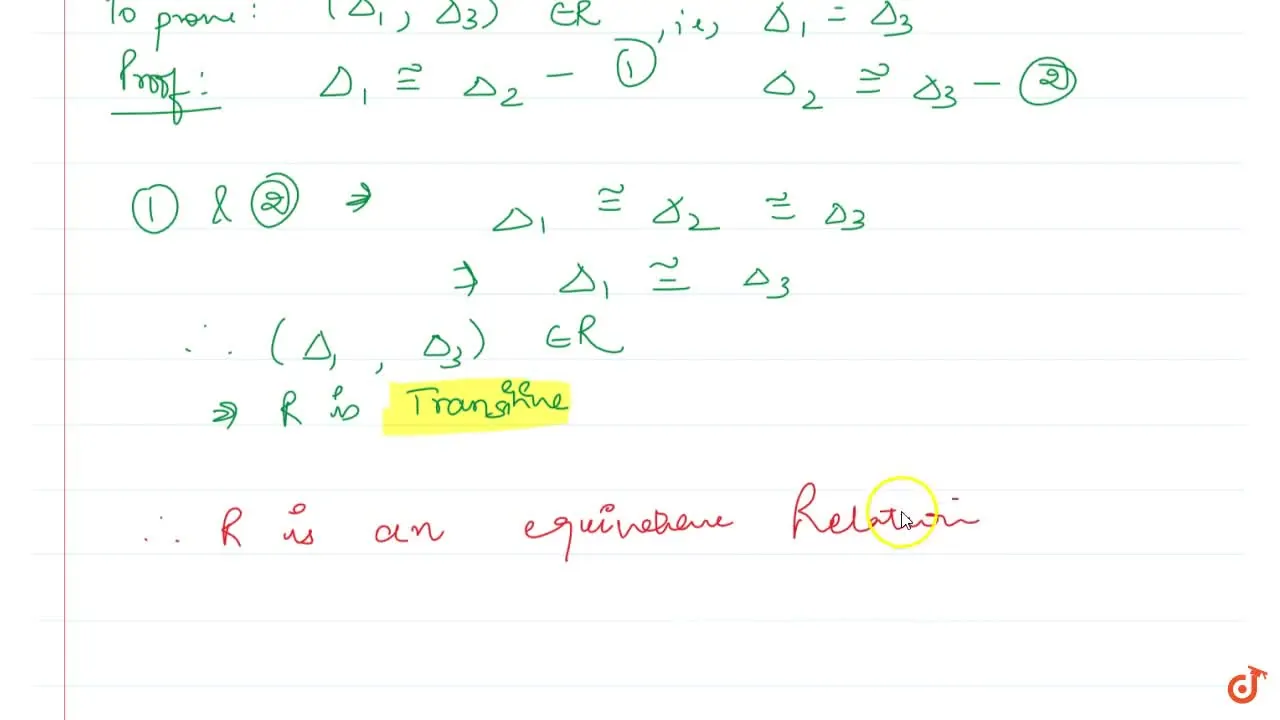Show that the relation ‘is congruent to’ on the set of all triangles in a plane is an equivalence relation
Now, T= set of all triangles
\begin{aligned}
&\mathrm{R}: \mathrm{T} \rightarrow \mathrm{T} \\
&\mathrm{R}=\left\{\left(\mathrm{T}_{1}, \mathrm{~T}_{2}\right): \mathrm{T}_{1} \cong \mathrm{T}_{2}\right\}
\end{aligned}
(i) For reflexive
T1≅T1
So, (T1,T1)∈R [all△s≅→itself]
So it is a reflexive relation.
(ii) For symmetric
$$
\begin{aligned}
&\operatorname{Let}\left(\mathrm{T}_{1}, \mathrm{~T}_{2}\right) \in \mathrm{R} \Rightarrow \mathrm{T}_{1} \cong \mathrm{T}_{2} \\
&\Rightarrow \mathrm{T}_{2} \cong \mathrm{T}_{1}
\end{aligned}
$$
So, (T2,T1)∈R
Thus, it is a symmetric relation.
(iii) For transitive
Let(T1,T2)∈R⇒T1≅T2→(i)
(T2,T3)∈R⇒T2≅T3→(ii)
From equation (i)&(ii), we get
$$
\begin{aligned}
&T_{1} \cong T_{2} \cong T_{3} \\
&T_{1} \cong T_{3} \Rightarrow\left(T_{1}, T_{3}\right) \in R
\end{aligned}
$$
Thus, it is a transitive.
Hence, given relation is an equivalence.
Related Playlists
Similar Questions
Show that the relation is parallel to on the set S of all straight lines in a plane is an equivalence relation.
View SolutionWhat is an equivalence relation?
Show that the relation of'similarity' on the set S of all triangle in a plane is an equivalence relation.View SolutionShow that set of all parallel lines in any plane is an equivalence relation.
View SolutionProve that the relation congruence modulo m on the set Z of all integers is an equivalence relation.
View SolutionThe inverse of an equivalence relation is an equvalence relation
View SolutionRelation " parallel" in the set of all straight lines in a plane is :
View SolutionShow that the relation R on the set Z of integers, given by R={(a, b):2 divides a−b} , is an equivalence relation.
View SolutionShow that the relation R defined on the set A of all triangles in a plane as R={(T1, T2):T1 is similar to T2) is an equivalence relation. Consider three right angle triangle T1 with sides 3, 4, 5; T2 with sides 5, 12, 13 and T3 with sides 6, 8, 10. Which triangles among T1, T2 and T3 are related?
View SolutionShow that the given triangles are congruent.
 View Solution
View SolutionThe relation ''is a factor of'' on the set N of all natural number is not
View Solution


